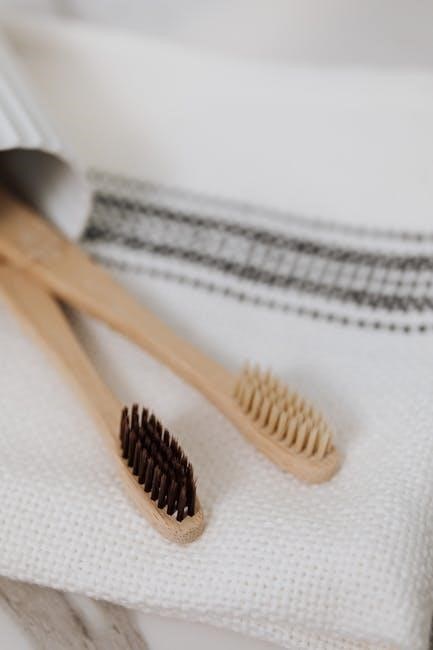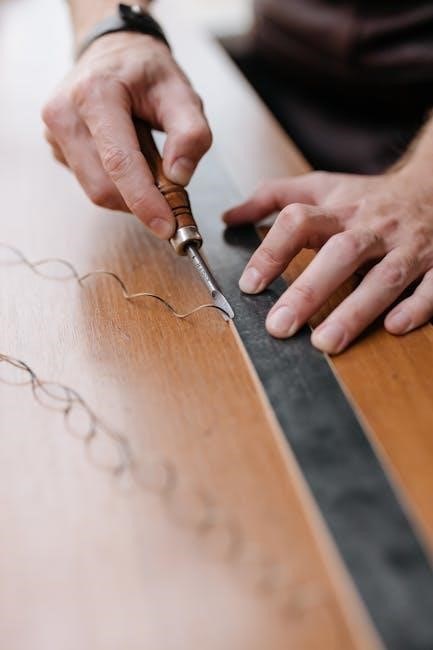The texture of a toothbrush plays a crucial role in maintaining oral health. Soft bristles are generally recommended as they are gentle on gums and tooth enamel, promoting effective cleaning without causing damage. This importance is emphasized by dental professionals worldwide.
1.1 Why Bristle Texture Matters for Oral Health
Bristle texture significantly impacts oral health by influencing gum safety and cleaning effectiveness. Soft bristles gently clean teeth without irritating gums, while hard bristles can cause enamel wear and gum recession. Dental professionals emphasize that proper texture selection prevents damage and ensures thorough plaque removal, maintaining overall oral hygiene and health.
1.2 Brief Overview of Manual Toothbrush Types
Manual toothbrushes vary in design, with bristle texture being a key differentiator. They are categorized into soft, medium, and hard bristles. Soft-bristled brushes are most common, recommended for gentle cleaning and gum protection. Medium and hard bristles are less frequently advised, often for specific cases under professional guidance. Each type serves unique oral care needs.

Recommended Bristle Texture by Dental Professionals
Dental professionals consistently recommend soft-bristled toothbrushes as the standard choice for oral care. They are gentle on gums and enamel, reducing the risk of damage during brushing.
2.1 Soft Bristles: The Most Common Recommendation
Soft-bristled toothbrushes are the most widely recommended by dentists due to their gentle nature. They effectively clean teeth without causing gum irritation or enamel wear, making them suitable for most individuals, including those with sensitive gums or teeth. Regular use of soft bristles helps maintain oral health while preventing potential damage from firmer options.
2.2 Medium and Hard Bristles: When and Why They Are Not Advised
Medium and hard-bristled toothbrushes are generally not recommended as they can cause gum irritation and enamel wear. They are too firm for most individuals, potentially leading to cavities and gingivitis. Dental professionals advise against their regular use, except in rare cases where a dentist specifically recommends them for unique oral health needs.

American Dental Association (ADA) Guidelines
The ADA recommends soft-bristled toothbrushes to prevent enamel wear and gum damage. Their guidelines emphasize gentle cleaning for oral health, applying to both manual and electric brushes.
3.1 ADA Recommendations on Bristle Texture
The ADA endorses soft-bristled toothbrushes for their gentleness on gums and tooth enamel. They suggest avoiding medium or hard bristles, which can cause damage. Soft or extra-soft bristles are ideal for sensitive teeth and gums. The ADA also recommends bristles with rounded tips to prevent gum irritation and multi-layer or angled designs for thorough cleaning, aligning with their standards for effective oral care.
3.2 Importance of ADA Certification for Toothbrushes
ADA certification ensures toothbrushes meet rigorous safety and effectiveness standards. The ADA Seal is awarded after testing and review, guaranteeing the product is safe for oral use. This certification helps consumers trust the quality of the toothbrush, knowing it aligns with professional dental standards and recommendations for oral care.

Bristle Texture and Gum Health
Bristle texture significantly impacts gum health. Soft bristles gently clean without irritating gums, while hard bristles can cause abrasion and potential gum damage, emphasizing the need for soft options.

4.1 How Soft Bristles Protect Gums
Soft bristles are designed to be gentle on gums, reducing the risk of irritation and abrasion. They effectively clean without causing damage, making them ideal for sensitive gums and promoting long-term gum health. This texture is particularly recommended for individuals with gum sensitivity or those prone to gum recession.
4.2 Risks of Hard Bristles for Gum Tissue
Hard bristles can cause gum irritation, abrasion, and recession if used aggressively. Prolonged use may lead to bleeding gums, a sign of gum disease, and weaken the gum line, making teeth less stable. Dental professionals strongly advise against hard bristles for regular use due to these risks.

Bristle Texture and Tooth Enamel
Bristle texture significantly affects tooth enamel health. Soft bristles minimize enamel wear, while hard bristles can cause irreversible damage, making teeth more sensitive and prone to decay over time.
5.1 Preventing Enamel Wear with Soft Bristles
Soft-bristled toothbrushes are highly effective in preventing enamel wear. They gently remove plaque without causing abrasion, protecting the enamel from potential damage. This is particularly important for individuals with sensitive teeth or those prone to enamel erosion. Regular use of soft-bristled brushes helps maintain enamel integrity, ensuring long-term oral health and preventing sensitivity. Dental professionals widely recommend this approach for optimal results.
5.2 The Impact of Hard Bristles on Tooth Enamel
Hard-bristled toothbrushes can cause significant wear on tooth enamel due to their abrasive nature. Over time, this can lead to micro-scratches, increasing sensitivity and risking enamel erosion. The constant friction may also expose underlying dentin, making teeth more susceptible to decay. Dental professionals strongly advise against using hard bristles for regular brushing to preserve enamel health and prevent long-term damage.

Special Cases and Alternative Recommendations
Special cases may require alternative bristle textures. Extra-soft bristles are ideal for sensitive gums, while medium bristles are rarely recommended for specific oral health needs.
6.1 Extra-Soft Bristles for Sensitive Teeth and Gums
Extra-soft bristles are specifically designed for individuals with sensitive teeth and gums. They minimize discomfort and prevent further irritation, making them an ideal choice for those with heightened sensitivity. These bristles are gentle yet effective, ensuring proper cleaning without causing damage or pain. Dental professionals often recommend them for patients with gum recession or sensitive enamel, as they provide a safer and more comfortable brushing experience.
6.2 Medium Bristles: Rare but Specific Uses
Medium bristles are rarely recommended but may be advised for specific cases, such as heavy plaque buildup or Tartar removal. However, dental professionals caution against regular use of medium bristles, as they can potentially damage gums and tooth enamel over time. They are generally not suggested for individuals with sensitive teeth or gums, emphasizing the importance of professional guidance in such cases.

Bristle Material and Texture
Soft bristles, often made from nylon, are recommended for their gentle care of gums and teeth. The ADA emphasizes soft bristles with rounded tips to avoid damage.
7.1 Nylon Bristles: The Most Common and Recommended Material
Nylon bristles are the most widely used material for toothbrushes due to their softness and durability. They are gentle on gums and tooth enamel, reducing the risk of irritation. Nylon bristles are less likely to cause micro-scratches, making them ideal for daily use. Dental professionals often recommend nylon bristles for their effectiveness in removing plaque without damaging oral tissues.
7.2 Natural vs. Synthetic Bristles: Texture Differences
Natural bristles are typically harder and less recommended, while synthetic bristles, like nylon, are softer and more durable. Synthetic bristles are less likely to cause gum irritation or enamel wear, making them the preferred choice for most dentists. They are also more consistent in texture and less prone to fraying, ensuring better oral hygiene for users.

Bristle Shape and Arrangement
Rounded bristle tips and multi-level arrangements enhance cleaning efficiency. Properly shaped bristles ensure even pressure distribution, protecting gums while effectively removing plaque from teeth surfaces.
8.1 Rounded Bristle Tips for Safety
Rounded bristle tips are designed to prevent gum injury and enamel wear. They ensure gentle contact with teeth and gums, reducing the risk of abrasion. Dental professionals recommend rounded tips as they are safer and more effective for proper oral hygiene. Properly shaped bristles promote even cleaning without causing harm, making them an essential feature for manual toothbrushes.
8.2 Multi-Level and Angled Bristles for Effective Cleaning
Multi-level and angled bristles are designed to enhance cleaning efficiency by reaching various tooth surfaces. These bristles target hard-to-reach areas, such as the back of molars, ensuring thorough plaque removal. Their unique arrangement allows for better alignment with tooth contours, improving overall cleaning effectiveness without compromising safety or comfort, making them a practical choice for manual toothbrushes.

Toothbrush Lifespan and Bristle Wear
A toothbrush should be replaced every three to four months or sooner if bristles fray. Worn bristles lose effectiveness, potentially leading to poor oral hygiene and health risks.
9.1 How Often to Replace a Manual Toothbrush
Dental professionals recommend replacing a manual toothbrush every three to four months or sooner if bristles become frayed or flattened. Visible wear signals reduced cleaning efficiency. Using a worn toothbrush can lead to inadequate plaque removal, potentially causing cavities and gingivitis; Regular replacement ensures optimal oral hygiene and aligns with dental care guidelines for maintaining healthy teeth and gums effectively.
9.2 Signs of Worn Bristles and Their Impact on Cleaning
Signs of worn bristles include fraying, flattening, or splitting at the ends. These worn bristles lose their effectiveness in removing plaque and bacteria, leading to inadequate cleaning. Over time, this can result in poor oral hygiene, potentially causing cavities, gingivitis, or gum irritation; Recognizing these signs ensures timely replacement, maintaining proper dental care and overall oral health effectively.
Soft-bristled toothbrushes are the best choice, protecting gums and enamel. The ADA recommends them, and regular replacement ensures effectiveness. Choose soft for optimal oral health.
10.1 Summary of Key Points
Soft-bristled toothbrushes are universally recommended for their gentleness on gums and enamel. The ADA emphasizes their safety and effectiveness, while hard bristles pose risks. Regular replacement every three months ensures proper cleaning. Worn bristles lose effectiveness, potentially leading to oral health issues. This approach balances cleanliness with protection, making soft bristles the optimal choice for daily use.
10.2 Final Tips for Choosing the Right Manual Toothbrush
Opt for a soft-bristled toothbrush to protect gums and enamel. Ensure it carries the ADA Seal of Acceptance for proven safety and effectiveness. Replace your toothbrush every three months or sooner if bristles fray. Consider rounded bristle tips for gentleness and angled or multi-level designs for better cleaning. Extra-soft options are ideal for sensitive teeth or gums, while medium bristles are rarely advised unless specified by a dentist.
